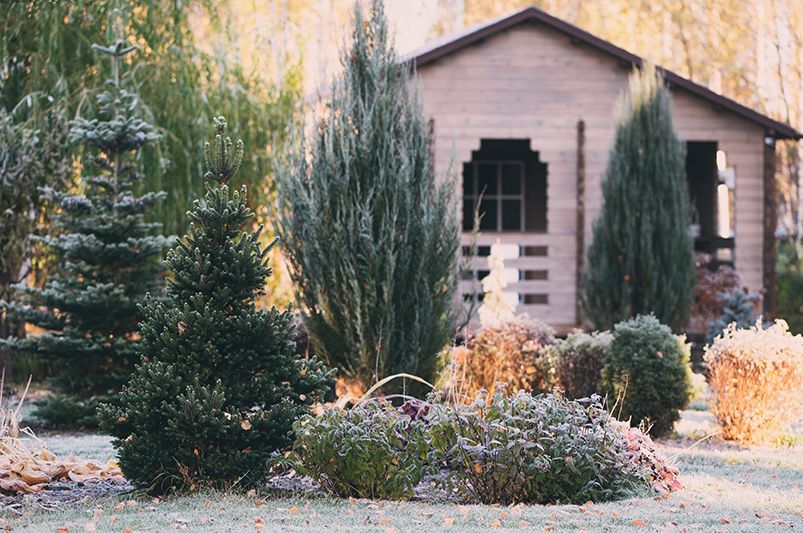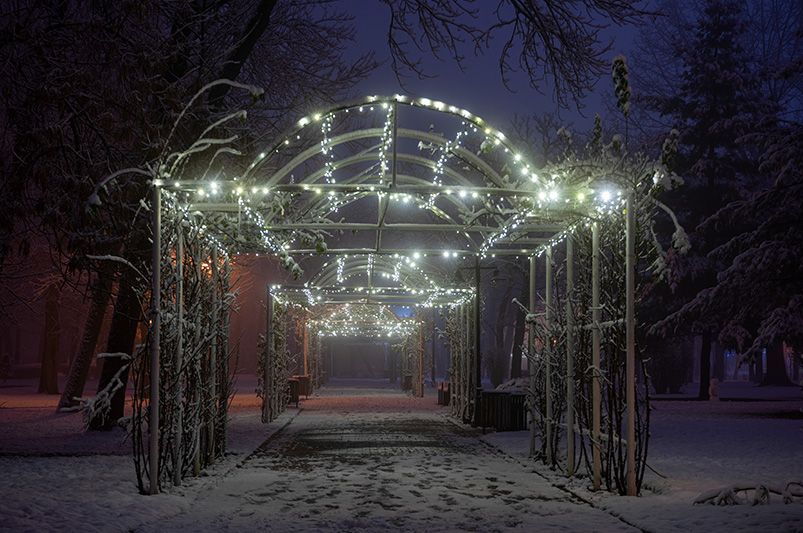
Captivating Winter Garden Design Ideas
Published: 26/11/2024 | Updated: 26/11/2024
Key Highlights
- Don't let your garden fade into the background during winter.
- Discover captivating design ideas to infuse life and beauty into your winter landscape.
- Learn about plants that thrive in colder temperatures, adding color, texture, and structure.
- Uncover the secrets of hardscaping and lighting to create stunning focal points.
- Transform your garden into a haven for wildlife throughout the winter months.
Introduction
As the air gets cooler and days are shorter, you might think gardening is done for the year. But with some planning and these garden design ideas, you can make a winter garden that looks beautiful and interesting, even in the coldest weather. Change your outdoor space into a winter wonderland. Use features that add structure, color, and life to your garden all through winter.


Essential Elements of Winter Garden Design

A good winter garden starts with smart planning and choosing the right plants. First, look at your garden's current setup. Find spots that may seem empty after deciduous trees lose their leaves.
Think about what can make your garden look nice in winter. You can add evergreen foliage, colorful stems, unique bark, and seed heads that last. By mixing these elements, you can create a multi-layered and interesting winter garden.
Incorporating Evergreens for Year-Round Color
Evergreen plants are important for a beautiful winter garden. They bring color and shape when other trees, like deciduous trees, have no leaves. These plants create a lively background for the other seasonal items, making the garden nice to look at all year round.
You can find evergreens in many shapes, sizes, and shades of green. Tall ones like blue spruce and dwarf Alberta spruce stand proudly. There are also low-growing plants like heathers and creeping junipers. For more charm, pick evergreens with different colors on their leaves or those that have colorful berries, like holly bush or winterberry.
When you choose where to plant your evergreens, think about how much light they need. Many evergreens like full sun, but some can grow in shady spots too. This makes them flexible choices for your winter garden design.
The Role of Hardscaping in Winter Gardens
Hardscaping elements are known as the "bones of the garden." They are important for making the garden look good in the winter months. These features give shape when plants are not visible or are covered by snow.
Patios, walkways, walls, and fences serve as the design style in your garden. They help direct the eye and add interest. Using materials that differ in color or texture can make them stand out more. For example, a dark fence can make a great background for snow-covered ornamental grasses or the bright red stems of red twig dogwood.
Here are some popular hardscaping features to think about for your winter garden:
- Patios and walkways: They create cozy spots to enjoy the outside in winter.
- Trellises and arbors: Even when they do not have climbing plants, they make beautiful shapes against the winter sky.
- Walls and fences: They offer privacy and help showcase beautiful plant combinations.

Selecting Plants for Winter Interest
Evergreens are great for a strong garden base. Adding deciduous plants that have special winter features can make your garden even better. Choose shrubs and trees with colorful bark, unique branches, or berries that stay attractive even after the leaves drop.
Think about how everything looks together. Make sure there is a nice mix of textures and forms for a beautiful winter landscape. Put together plants that have colors that match or use different shades to make eye-catching points.
Deciduous Shrubs with Colorful Bark
Deciduous shrubs with bright bark can really change your winter garden. They show off their branches when other plants are covered in leaves. This makes a lovely scene against the snow or chilly background.
One well-liked choice is the red twig dogwood (Cornus sericea). As it gets colder, its stems turn a bright red which adds vibrant color to the garden. The paperbark maple (Acer griseum) is another great option. Its bark peels off in layers, showing its warm cinnamon-brown color underneath. Also, the yellow twig dogwood (Cornus sericea 'Flaviramea') has golden stems that brighten up the area.
Think carefully about where to plant these shrubs to see their bark best. Place them where you can look at them closely or where the low winter sun will highlight their colors and textures.
Perennials and Grasses that Offer Textural Beauty
As the growing season ends, many perennials and grasses leave beautiful seed heads. They bring interesting textures to the winter landscape. Their soft forms and gentle colors create a nice beauty that stands out against the stronger parts of the winter garden.
Ornamental grasses, like feather reed grass (Calamagrostis x acutiflora 'Karl Foerster') and switchgrass (Panicum virgatum), are famous for their strong seed heads. These seed heads remain tall during winter and move gently in the wind. Likewise, perennials such as sedum 'Autumn Joy' and coneflowers (Echinacea purpurea) grow sturdy seed heads. They are not only attractive but also give food to birds.
Don't rush to cut back these old blooms. Let them stay through winter. They add structure and texture to your garden.
Adding Color and Light to the Winter Garden

The winter garden might look quiet, but there are ways to add bright colors and lights. Adding pops of color can light up gray days, and good lighting lets you enjoy your garden even after dark.
You can choose plants with berries, late-winter blooms, and colorful stems to make your garden exciting. Using smart lighting options not only lets you enjoy your garden longer but also brings out its structure.
Winter-Blooming Flowers to Brighten Gray Days
Even in the cold of winter, some flowers stand strong to add bright colors to the area. These winter flowers bring joy with their vividness and nice smells, turning your garden into a delight for the senses.
Witch hazel (Hamamelis x intermedia) shows off its thin, sweet-smelling flowers in yellow, orange, and red, signaling that spring is near. Another favorite is the Lenten rose (Helleborus spp.), which has soft blooms in pink, purple, white, and green.
Plant these strong flowers near your walkways or doorways. This way, you can enjoy their beauty and scent as you come in or go out of your home.
Creative Lighting Strategies for Longer Nights
As the days get shorter and it gets dark early, think about adding creative lighting to your winter garden. This will help shine a light on its beauty even at night. Good lighting can show off the design of your garden, reveal interesting textures, and make a cozy and welcoming space.
Try using different lighting methods to add depth and dimension. Uplighting can make a beautiful tree or statue stand out. Path lights can brighten walkways and keep them safe to walk on. String lights bring a fun feel and can be hung in trees or along fences.
Here are some creative lighting ideas for your winter garden:
- Spotlights: Brighten up special spots like sculptures, trees with unique bark, or evergreen shrubs.
- Path lights: Light up walkways and help keep the garden safe at night.
- String lights: Bring a cheerful look to trees, fences, or pergolas.

Attracting Wildlife to Your Winter Garden
A lively garden brings joy all year. By choosing the right plants, you can attract birds and helpful insects, even in winter. This adds more life to your garden and keeps nature lovers interested.
Pick plants that produce berries or seeds for the birds. Also, think about adding places where insects can find shelter during the colder months.
Plants that Provide Food for Birds
Transform your winter garden into a friendly spot for birds. Add plants that give food during the cold months. Berries, which have important sugars for energy, and seed heads, full of healthy fats and proteins, help birds thrive in tough weather.
Plants like winterberry (Ilex verticillata) show bright red berries all winter. Crabapple trees (Malus spp.) also draw many types of birds. If you want a simpler look, try using native plants like coneflowers and sunflowers. Keep their seed heads intact to give birds a natural food source.
When you provide food and shelter in your garden, you help wildlife. You also support a healthy ecosystem.
Creating Habitats for Overwintering Insects
While many think winter means nothing is alive, lots of helpful insects hide in our gardens to stay warm. By making places for them to overwinter, you can make your garden a better place. This change will help more pollinators and pest-eating insects thrive when spring arrives.
You can provide shelter by leaving parts of your garden untouched. For instance, you might wait to clean up leaves around trees and shrubs. This layer of leaves keeps insects warm while they wait out the cold. You could also add insect hotels or bunches of hollow stems in your garden to give overwintering insects safe places to stay.
Keep in mind, a garden with many types of plants and animals is a strong garden. When you create homes for different creatures, you help create a healthy environment for both wildlife and your garden.
Conclusion
Embrace the beauty of winter with a garden design that looks good all year. Use evergreens, hardscaping, and choose plants for winter interest. This will help you create a lovely outdoor space, even when it's cold. Add bright colors with flowers that bloom in winter and use creative lighting to make those gray days feel brighter. Remember to include plants that offer food for birds and homes for insects during winter. Change your garden into a winter wonderland that looks nice and helps nature. Enjoy all the beauty that nature can provide in your backyard!
Frequently Asked Questions
What are the best plants for a winter garden?
The best plants for a winter garden are those that look good in different seasons. You can choose colorful stems like red twig dogwood. Evergreen options like holly or spruce are also great. Consider deciduous trees that have bright bark, like paperbark maple. Look for plants that give texture too, even when they are not growing.
Need Assistance for a Complete Landscape Makeover?
Shrubhub’s landscape design packages can significantly transform the lives of homeowners by delivering customized, professional landscaping plans tailored to their unique space and personal style. With the ease of online collaboration, you are guided step-by-step through a design process that fundamentally reshapes your outdoor environment. The result is an aesthetically pleasing and functional outdoor living area that maximizes the potential of your property.


